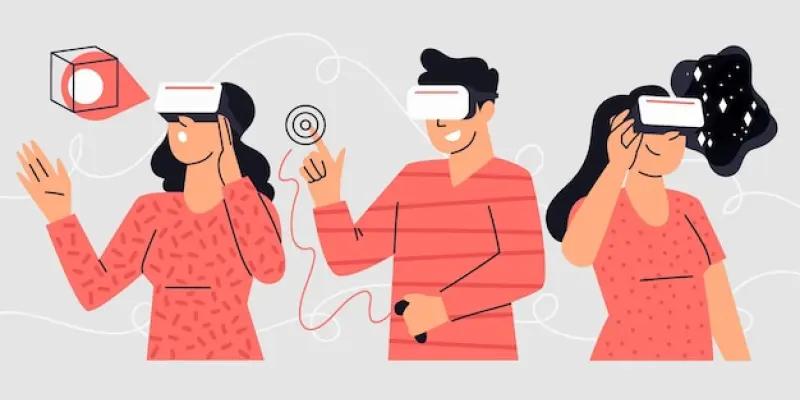Virtual reality is rapidly transforming various facets of modern life, yet one prevalent challenge remains: ensuring universal accessibility for all users. Those with mobility limitations, such as individuals reliant on wheelchairs or experiencing restricted physical movement, often face barriers when engaging with popular VR experiences like games and social platforms. Standard VR setups typically demand actions that can be difficult to execute for such users, including gestures like swinging arms or stepping sideways. This discrepancy not only limits participation but creates a digital divide, highlighting the need for inclusive social spaces in the virtual realm. Addressing this issue, researchers at the University of Waterloo have spearheaded a groundbreaking initiative with the creation of MotionBlocks, designed specifically to accommodate the needs of mobility-limited individuals in VR environments. Their solution is an essential step towards transforming VR into an inclusive and equitable technology.
Understanding the Challenges of VR Accessibility
The Physical Limitations in Conventional VR Systems
Traditional VR experiences often require substantial physical engagement from users, demanding complex motions that pose significant challenges for individuals with limited mobility. These systems are generally designed without considering the varying physical capabilities of users, inadvertently excluding those who cannot perform specific movements such as side-stepping or extensive arm motions. This exclusion not only limits access to recreational activities but restricts participation in broader digital community interactions, contributing to isolation among those unable to engage fully. In recognition of this systemic issue, researchers undertook a detailed study to understand the underlying barriers faced by mobility-limited users. Their investigation involved several participants who shared insights and personal experiences of navigating VR environments, which served as the foundation for informed design decisions in developing MotionBlocks.
Crafting Innovative Solutions: MotionBlocks
The creation of MotionBlocks marks a pivotal step in addressing the accessibility challenges inherent in VR systems. Designed to empower users by allowing them to customize control settings, MotionBlocks transforms the way individuals interact within virtual spaces. Similar to the concept of remapped controls in traditional gaming, it enables users to adapt VR configurations to suit their physical capabilities. However, MotionBlocks goes a step further by integrating dynamic remapping within a 3D framework, converting manageable movements into those required by the game, such as seamless arm swings necessary in action-centric games like Beat Saber. This innovative approach not only enhances user enjoyment but actively reduces physical strain, thereby fostering a more inclusive and immersive experience for mobility-limited individuals.
Progress Through Pilot Studies and Future Implications
Positive Participant Feedback and Outcomes
Following the initial phase of collecting user experiences, MotionBlocks underwent rigorous testing involving multiple participants. The feedback from these sessions emphasized the transformative impact of the tool, with users reporting enhanced enjoyment and significantly reduced fatigue during their VR interactions. Beyond physical comfort and enjoyment, participants conveyed a newfound sense of inclusion within digital spaces previously inaccessible to them. The pilot tests served to validate MotionBlocks as a robust proof-of-concept, reinforcing the potential for industry-wide integration of similar accessibility modules in VR systems. While the tool itself is not positioned for commercial release, its successful implementation serves as a catalyst for broader discussions on inclusivity in technological design, advocating for a universal approach that encompasses diverse user capabilities.
Towards Industry-Wide Adoption and Inclusivity
The development of MotionBlocks underscores the urgent need for VR systems to evolve towards more inclusive frameworks. As technology continues to advance, the integration of adaptive solutions akin to MotionBlocks could redefine standard accessibility practices within virtual environments. By embedding modular geometric remapping techniques, developers can ensure that all users, regardless of their physical limitations, can engage fully and comfortably in VR experiences. The research paper detailing MotionBlocks, presented at the prestigious CHI Conference on Human Factors in Computing Systems, illustrates the significant strides achievable through collaborative and innovative research efforts. These findings pave the way for industry stakeholders to recognize and address the accessibility divide, ultimately fostering an inclusive digital landscape that empowers every individual to participate, explore, and enjoy the immersive world of virtual reality.
A Vision for Inclusive Virtual Reality
This journey towards inclusivity highlights the transformative potential of technology in bridging digital divides and fostering equitable access to virtual environments. With MotionBlocks serving as a model, the path toward universal accessibility in VR is promising, encouraging developers to prioritize adaptive solutions for diverse user needs. As the technology landscape evolves, adopting inclusive design practices will be crucial in ensuring that all individuals, irrespective of their physical capabilities, can partake in immersive experiences without limitations. The successful implementation of MotionBlocks exemplifies how collaborative efforts and innovative research can drive industry-wide change, paving the way for a future where the boundaries of accessibility are continually expanded, leading to enriched and inclusive virtual experiences for everyone.

